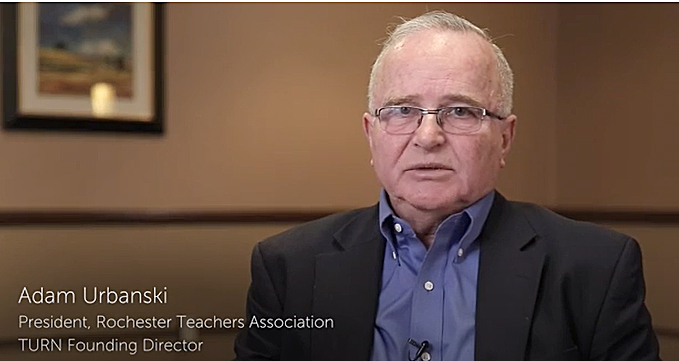
Southwest Tribune Newspaper Rochester, NY
In the past, the social and psychological effects which have stemmed from the high concentration of city students living below the poverty line have commonly been deemed as the “root cause” of the district’s inability to significantly increase its graduation rates, and low student achievement scores.
And, often, public officials’ traditional response has been to ask for more money, and more social services, in order to tackle the problem.
However, better school buildings, and increased services, on average, seem to have been unable to change the situation.
As a result, the Southwest Tribune has asked, in a sit-down interview with Rochester Teachers Association (RTA) president Adam Urbanski, what, in addition to and beyond the traditional responses, the district should pursue as a strategy that would significantly and promptly reverse the systematic trend of low graduation rates, and low student achievement scores.
“To fully correct the problem, we must embrace diversity,” Urbanski stated. “It’s a shame the district is not encouraging more cultural information in its curriculum, so the kids can develop self- affirmation. As a union, we try to do as much as we can. We train our teachers how to teach children of color. We recognize these mostly-female, mostly-middle class, mostly-suburban teachers come here, and they are totally clueless as far as knowing anything about the students. You address it by education. We start by teaching the suburban, white teachers about the culture, history and realities of the students. We don’t, without thought, present them with a Eurocentric curriculum, and expectations totally oblivious to the children’s own culture, heritage and history. Secondly, we aggressively pursue affirmative action to make sure we increase the proportion of teachers who that child can recognize themselves in, including black and Latino teachers and administrators.”
“I remember, years ago, we were full partners with the district in recruiting teachers through Historically Black Colleges or Universities (HBCUs), to increase the proportion,” he said. “But recently, the district has dropped that. I think they need to pick it up again, and/or develop a metropolitan school system.”
According to a recent study titled, “Few minority teachers in classrooms, gap attributed to graduation rates,” by the Center for American Progress, “Increasing the number of teachers of color is not only a matter of a philosophical commitment to diversity in career opportunities. Teachers of color provide real-life examples to minority students of future career paths. In this way, increasing the number of current teachers of color may be instrumental to increasing the number of future teachers of color. And, while there are effective teachers of many races, teachers of color have demonstrated success in increasing academic achievement for engaging students of similar backgrounds. This is a problem for students, schools, and the public at large. Teachers of color serve as role models for students, giving them a clear and concrete sense of what diversity in education–and in our society–looks like. A recent review of empirical studies also shows that students of color do better on a variety of academic outcomes if they’re taught by teachers of color.”
In addition, a recent survey of teachers from the National Center for Education Information found that, in 2011, 84 percent of public-school teachers were white. This wasn’t much of a change from 25 years before, in 1986, when the survey found 91 percent of teachers in those same schools were white.
And, in the Rochester City School District, more than 80 percent of teachers have identified themselves as white, compared to a student body that is comprised of more than 80 percent minorities.
“The whole notion of equity, that you can’t have excellence without equity, I have believed always, without exception, before I became a teacher,” Urbanski stated. “Equity and excellence are inseparable. Excellence without equity is not excellence, it’s just privilege. For me, there’s only one criterion; it’s got to be good for kids, and fair for teachers. The two are a pretty good fit. For that reason, I’m more of a reformer. In addition to this job, I am also vice president of our national union, the American Federation of Teachers. So, I am trying to get unions to rethink who their client is. Unions automatically think that teachers are their clients. I’m saying teachers will do well, ultimately, only if their students do well. The misinterpretation for unions is that, your client is only the teacher. However, the client of the teacher is the student. So, our attention at the RTA is not how you protect the teacher, but how could you help the teacher be more effective with the students?”
Diversity in the classroom is also a perennial concern among leaders of the National Education Association (NEA), the nation’s largest teacher’s union.
“The demand for black teachers is always high, in public schools across America,” former NEA president Reg Weaver, who is also a black male, said. “The sad reality is that a young boy could go through his entire education, without ever having a teacher who looks like me.”In addition, “If a teacher does not care about the kids, they shouldn’t be a teacher,” Urbanski stated. “They should be removed from teaching. It is one true reason why I chose to live in the city. Yes, it is critically important that children have adults around them, including teachers who know them, and know them well, and who care about them. If they don’t know them well, you can’t possibly care about them. You can’t care about someone you don’t know. You don’t want to care about someone you don’t want to know. The union has yet to persuade the public that we care about the kids, as much as we care about the members. I do. The best way for that to happen, is to establish more effective partnerships with the kids’ families, and communities. Until we know the families, and the communities in which the children exist, we don’t know them in a contextualized way. Because your child is in my class, I only know him or her in my class. I’ve got to know more than that.”
According to a recently-published study in the Economics of Education Review, “Black, white, and Asian students benefit from being assigned to a teacher that looks like them. Their test scores go up in years when their teacher shares their ethnicity, compared to years when their teacher has a different ethnicity. Effects are generally largest for elementary-aged students, and students who are lower performing. Elementary-aged black students seem to particularly benefit from demographically similar teachers.”
“I am going to redouble our efforts to persuade the district they should resume what we’ve done in the past, to aggressively pursue affirmative action to diversify the teacher force, so we can have an even better shot of effectively knowing our students, and teaching our students,” Urbanski stated. “Honestly, I believe it’s a strategy long overdue.”





